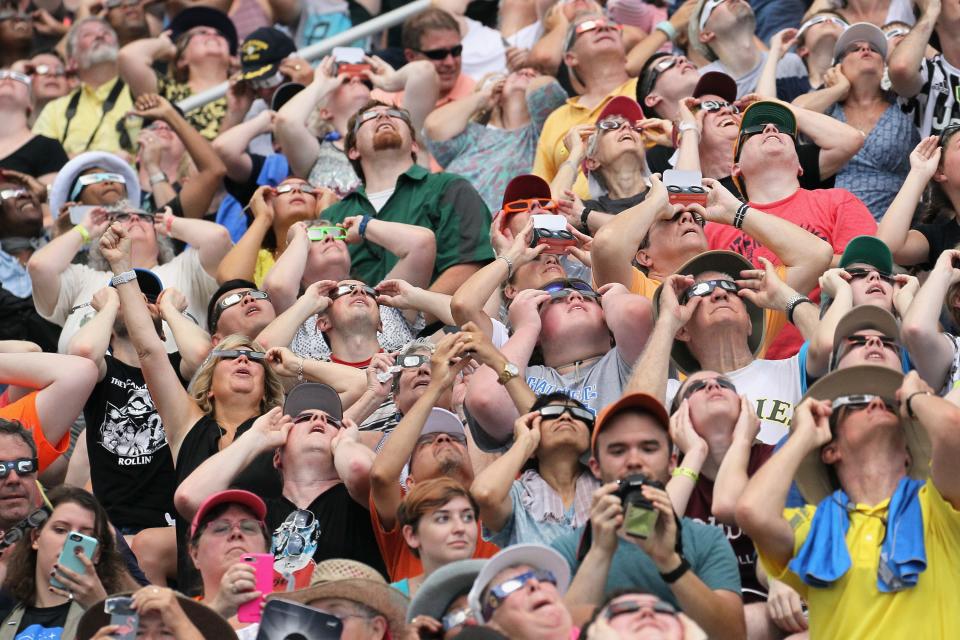Solar Eclipse 2024: Expect Flight Delays and Traffic Jams from Texas to Maine

Pete Marovich/Getty
Millions of people are expected to travel to see the total solar eclipse on April 8. As a result, large swaths of the country could be faced with traffic jams and flight delays in the coming days, government agencies warn.
“This rare event may be a once-in-a-lifetime for some, but could have widespread impacts on the traveling public,” Federal Highway Administration (FHWA) administrator Shailen Bhatt said in a video message in late March. “So please plan ahead to arrive early, and, if you can, stay put to avoid traffic congestion.”
According to the FHWA, 32 million Americans live within the eclipse path—which sweeps from the Mexican border in Texas up to the Canadian border in Maine—and millions more are expected to travel into the zone for the event. That means even those who aren't traveling for the eclipse should prepare for crowds of umbraphiles in many parts of the country, particularly at and around certain airports and roadways.
Last week, the Federal Aviation Administration (FAA) issued an alert flagging that the already busy spring break week will be exacerbated by eclipse-related travel. While the peak travel day was Thursday, April 4 (with 50,670 scheduled flights), fliers should also expect busy airports on Friday, April 5, the FAA says.
The agency has even issued a domestic notice warning of “possible impacts to air traffic and airports along the eclipse path” from April 7 to April 10. Higher volumes of traffic are expected at airports of all sizes within the eclipse zone, especially in the greater Boston, Chicago, Cleveland, Fort Worth, Houston, Indianapolis, Kansas City, and Memphis regions. Aircraft may be subject to potential airborne holding and reroutes, the notice says, and arrivals to some airports could possibly be restricted due to the increased volume. For travelers, all that could result in flight delays, traffic jams on the way to the airport, a lack of parking spots, and long security lines.

Solar Eclipse Visible Across Swath Of U.S.
While the last solar eclipse visible from the United States was just a few years ago ago in 2017, the anticipation for this year's is even greater. One reason for this (in addition to the duration of totality being almost double in length this time) is the fact that the 2024 eclipse path is much wider and more densely populated than 2017's.
“What makes it even more appealing is that there are so many major cities and populated areas along the path of totality this time,” Expedia travel expert Christie Hudson tells Condé Nast Traveler, citing Austin, Dallas, Dayton, and Indianapolis as 2024 eclipse hot spots.
The travel booking company has seen searches for hotels within the path go up 1,100% compared to the same period last year, including a 1,155% rise in searches for Burlington, Vermont; 985% for Little Rock, Arkansas; 705% for Dayton, Ohio; 645% for Buffalo, New York; and 545% for Indianapolis.
Likewise, Airbnb has also experienced a surge of more than 1,000% in searches compared to last year for what it calls “up to 268 seconds of darkness.” In fact, one in four Airbnb guests with a booking the night before the eclipse has a stay booked within the totality path, the company says.
How to avoid eclipse traffic jams
Traffic congestion warnings have been released for totality path states including Texas, Arkansas, New York, and Maine. Rental car company Hertz has seen a 3,000% increase over last year in advance bookings for cities within the totality pathway, the American Automobile Association (AAA) says.
When the eclipse hits, with totality starting at 1:27 pm local time in Texas and ending at 3:35 p.m. local time in Maine, “the last thing you want is to be driving,” Hudson, of Expedia, says. “So make a day of it, bring a picnic, and make sure to get gas the night before.”
On the roadways, the most congested sections are likely to be rural roads in popular eclipse destinations that aren't built for such a high volume of travelers, an AAA spokesperson tells Traveler. Following the 2017 eclipse, four of the five most bottlenecked locations were not freeways, AAA data from transportation analytics data company Inrix shows. At the time, traffic lasted between 7 and 15.5 hours, with the longest backups ranging from 45 to 70 miles.
In Texas, the eclipse path follows much of Interstate 35, through Austin, Dallas, and Fort Worth, as well as smaller towns, a Texas Department of Transportation spokesperson told Time Magazine, warning of “possible significant delays” on both the main highway and farm roads. Austin NBC affiliate KXAN warns of backups on U.S. Highway 290, 281, and 183—the latter especially around Liberty Hill.
Over in Arkansas, AR Highway 70 to Benton and AR Highway 65 between Conway in Greenbrier are forecasted to be the busy zones, per the Time report.
Around Columbus, the Ohio Department of Transportation told the local NBC affiliate WCMH to expect high volumes on Interstate 70 in downtown and Zanesville, Interstate 71 in downtown, Interstate 75 in Cincinnati and Dayton, Interstate 475 on Toledo's southwestern side, and Interstates 76 and 77, plus State Route 8, in Akron. Real time congestion can also be tracked here.
Canada's side of the Niagara Falls in Ontario has preemptively declared a state of emergency as an estimated 1 million travelers flock to the photogenic waterfall, which lies in the eclipse path. On Friday morning, the city issued a map of road closures in Niagara Falls and Fort Erie.
To avoid getting caught in traffic following the eclipse, “consider staying longer at your eclipse-viewing destination afterward,” an AAA spokesperson tells Traveler. “Much like after a concert, hang out until the initial rush passes.”
Hudson concurs, saying: “There will be many crowds. Pack your patience—and your special eclipse viewing glasses!”
Originally Appeared on Condé Nast Traveler

